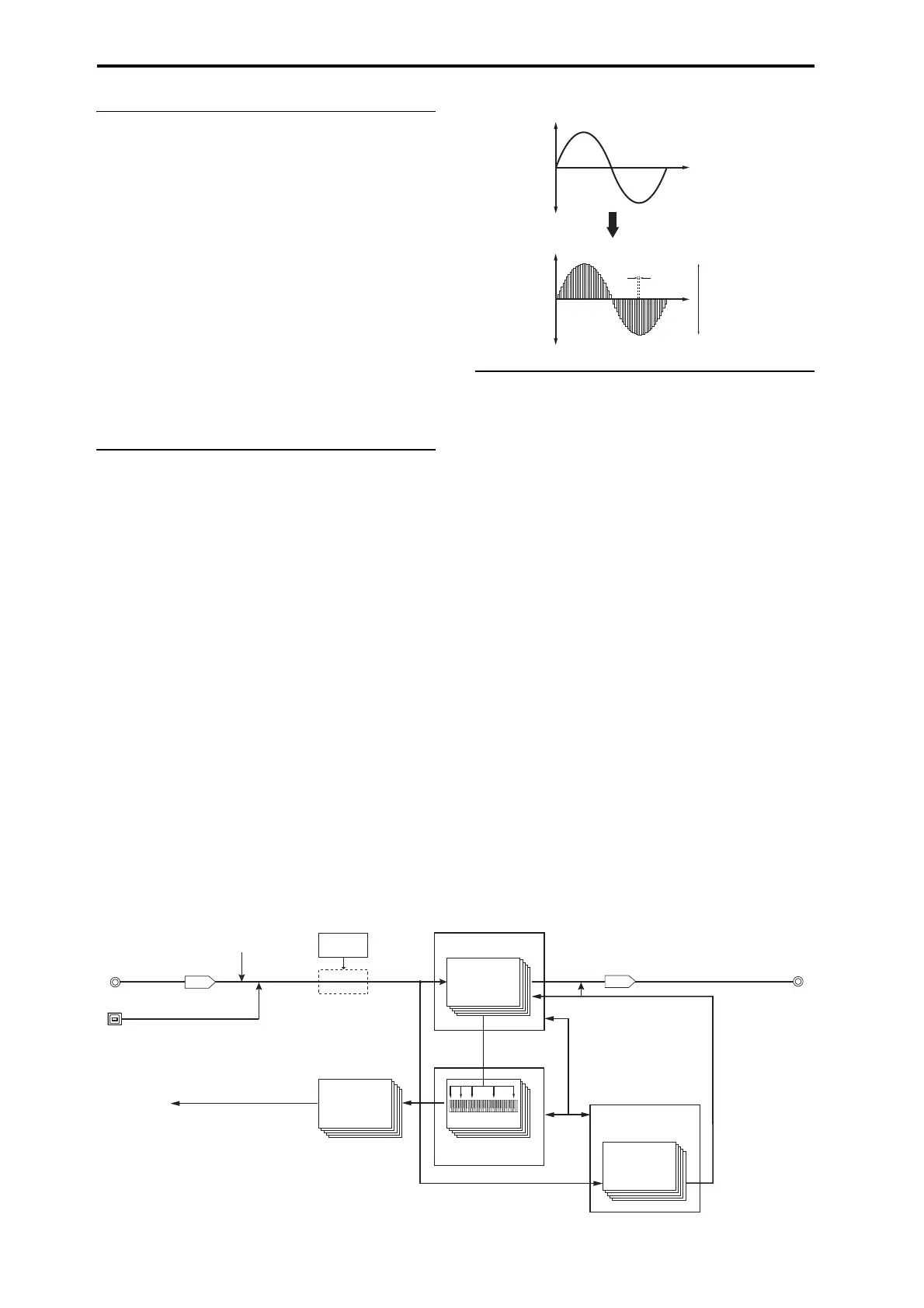Sampling (Open Sampling System)
124
PROGRAM, COMBINATION, SEQUENCER
modes
In PROGRAM, COMBINATION, and SEQUENCER
modes, you can resample a complete live performance
including filters, effects, ARP, and even sequencer playback.
You can also sample external audio sources, mix the
NAUTILUS sounds with the external audio and sample the
combined result, or even monitor the performance of the
NAUTILUS while sampling only the external source.
In-Track Sampling in SEQUENCER mode
In SEQUENCER mode, you can sample while playing along
with a Song, and automatically create note data to trigger the
new samples at the appropriate moment in the Song. You
can then manipulate these samples using the synthesis
abilities of the HD-1, for creative alternatives to HDR. This
is called “In-Track Sampling.”
Sampling frequency and bit resolution
As shown in the diagram, sampling reads the level of the
analog signal at fixed intervals along the time axis, and
stores the levels in memory as digital data.
The time between these intervals is called the “sampling
frequency.” 48 kHz (kilohertz) means that sampling is
performed 48,000 times each second, so that the intervals are
1/48,000 of a second apart— approximately 0.02083 ms
(milliseconds).
The higher the sampling frequency, the closer to the original
analog signal the waveform in memory will be.
Each level is read and converted into digital data. The
accuracy of the level measurement is determined by the bit
resolution. This process converts an analog signal with
infinite resolution into a digital signal with finite resolution.
With 16 bit resolution, each level is indicated in 65,536 steps
(the sixteenth power of two).
The greater the bit resolution, the closer to the original
analog signal the waveform in memory will be.
Samples and Multisamples
Samples
The data that is recorded (sampled) into internal memory or
loaded from a file is referred to as a sample or sample file.
Samples consist of the actual waveform data, and parameters
that specify how the data will be played back, such as Start,
Loop Start, and End Address. Samples can be used in
multisamples and drum kits.
SAMPLING mode supports a maximum of 16,000 Samples
at once. Samples in EXs and User Banks do not count
towards this maximum.
The NAUTILUS can share a single waveform among
multiple samples. This allows you to create multiple samples
with different playback addresses from the same waveform
without wasting internal memory. For example, suppose that
you have waveform data that records a voice saying “One-
Two-Three.” This single piece of waveform data could be
shared by three samples, with the playback of sample A
producing “One-Two-Three,” sample B producing “One-
Two,” and sample C producing “Two-Three.”
For more information, see “Copy” on page 615 of the PG.
Sampled digital
waveform
Time
Level
Level
Time
Analog waveform
16 bit
= 65,536 levels
of data
48 kHz
= 48,000 times every second
= 0.0208 mS cycle
AUDIO INPUTS
ADC
Analog/digital
convertor
Sample 0000 ... 15999
RAM
DAC
Digital/analog
convertor
AUDIO
OUTPUTS
Analog signal
Insert Eects
(Master Eects)
Digital signal
Analog signalDigital signal
Internal drive
RAM
Multisample 0000 ... 3999
Program
Used by Combinations
and Songs
WAVE File
Resampling
Programs, Combinations
and Songs
USB B
Conceptual diagram of the Open Sampling System

